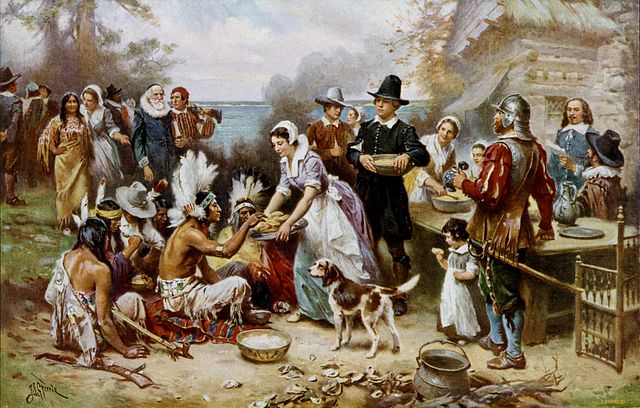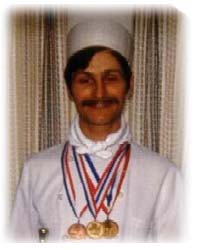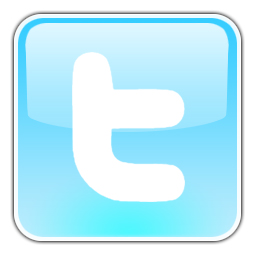
The Kitchen Project | History Project | Contact Us | About Us | Free Food History Course | Food History Search
Why Turkey? "I wish the eagle had not been chosen as the representative of our country. He is a bird of bad moral character... the turkey is a much more respectable bird, and withal a true original native of America." Since that time, turkeys have been extensively raised because of the excellent quality of their meat and eggs. Some of the common breeds of turkey in the United States are the Bronze, Narragansett, White Holland, and Bourbon Red. Unfortunately the Bradford document was lost after being taken away by the British during the War of Independence. Later it was rediscovered in 1854. And since then turkey turned out to be a popular symbol of the Thanksgiving Day. And today of all the the Thanksgiving symbols it has become the most well known.
Important dates in Thanksgiving history 1863 Lincoln proclaims National holiday 1941 Thanksgiving moved back for longer Christmas Shopping
The Pilgrims set ground at Plymouth Rock on December 11, 1620. Their first winter was devastating. At the beginning of the following fall, they had lost 46 of the original 102 who sailed on the Mayflower. But the harvest of 1621 was a bountiful one. And the remaining colonists decided to celebrate with a feast -- including 91 Indians who had helped the Pilgrims survive their first year. It is believed that the Pilgrims would not have made it through the year without the help of the natives. The feast was more of a traditional English harvest festival than a true "thanksgiving" observance. It lasted three days. Governor William Bradford sent "four men fowling" after wild ducks and geese. It is not certain that wild turkey was part of their feast. However, it is certain that they had venison. The term "turkey" was used by the Pilgrims to mean any sort of wild fowl. Another modern staple at almost every Thanksgiving table is pumpkin pie. But it is unlikely that the first feast included that treat. The supply of flour had been long diminished, so there was no bread or pastries of any kind. However, they did eat boiled pumpkin, and they produced a type of fried bread from their corn crop. There was also no milk, cider, potatoes, or butter. There was no domestic cattle for dairy products, and the newly-discovered potato was still considered by many Europeans to be poisonous. But the feast did include fish, berries, watercress, lobster, dried fruit, clams, venison, and plums. This "thanksgiving" feast was not repeated the following year. But in 1623, during a severe drought, the pilgrims gathered in a prayer service, praying for rain. When a long, steady rain followed the very next day, Governor Bradford proclaimed another day of Thanksgiving, again inviting their Indian friends.
It wasn't until June of 1676 that another Day of Thanksgiving was proclaimed.On June 20, 1676, the governing council of Charlestown, Massachusetts, held a meeting to determine how best to express thanks for the good fortune that had seen their community securely established. By unanimous vote they instructed Edward Rawson, the clerk, to proclaim June 29 as a day of thanksgiving. October of 1777 marked the first time that all 13 colonies joined in a thanksgiving celebration. It also commemorated the patriotic victory over the British at Saratoga. But it was a one-time affair. George Washington proclaimed a National Day of Thanksgiving in 1789, although some were opposed to it. There was discord among the colonies, many feeling the hardships of a few Pilgrims did not warrant a national holiday. And later, President Thomas Jefferson scoffed at the idea of having a day of thanksgiving. It was Sarah Josepha Hale, a magazine editor, whose efforts eventually led to what we recognize as Thanksgiving. Hale wrote many editorials championing her cause in her Boston Ladies' Magazine, and later, in Godey's Lady's Book. Finally, after a 40-year campaign of writing editorials and letters to governors and presidents, Hale's obsession became a reality when, in 1863, President Lincoln proclaimed the last Thursday in November as a national day of Thanksgiving. Thanksgiving was proclaimed by every president after Lincoln. The date was changed a couple of times, most recently by Franklin Roosevelt, who set it up one week to the next-to-last Thursday in order to create a longer Christmas shopping season. Public uproar against this decision caused the president to move Thanksgiving back to its original date two years later. And in 1941, Thanksgiving was finally sanctioned by Congress as a legal holiday, as the fourth Thursday in November.
|
Search for Food History Articles
More Links and Recipes
|
|||||||||||||||
E-Mail The Webmaster stephen@kitchenproject.com
© 1998- The Kitchen Project
Last updated November 26, 2019



